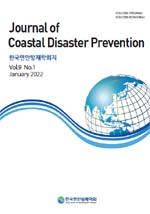In this study, we simulated storm waves induced by typhoon Maysak and Haishen in the Korean peninsula by using the third-generation numerical wave model SWAN(Simulating WAves Nearshore). We used the sea-surface wind data of KMA(Korea Meteorological Agency)’s operational meteorological model RDAPS(Regional Data Assimilation Prediction System), and JMA(Japan Meteorological Agency)’s weather forecast model JMA-MSM(Meso-Scale Model) as input forcing of the numerical wave model. In addition, the wind field of the tropical cyclone was established with JTWC(Joint Typhoon Warning Center)’s best track data for the storm wave simulation. We used two different source term options, which consider other physics of energy generation by wind and dissipation by whitecapping. Validation of the simulation result was conducted over statistical analysis with the observation data from KMA and KHOA(Korea Hydrographic and Oceanographic Agency)’s buoys. As a result, the whole scenario tended to overestimate significant wave height. The simulation result by using RDAPS as input forcing outperformed the result by using JMA-MSM. It denoted that the performance of a wave model depends on the accuracy of input forcing wind. The wind field by JTWC’s best track data was not suitable compared with the meteorological numerical model. ST6 simulated the wave height higher than Komen’s source term. However, Komen s source term simulated storm waves better than ST6 in this study, and further researches under various conditions are required to evaluate ST6 for the storm waves simulation. In the simulation of wave period parameters, it was hard to estimate the accuracy of the model, and other approaches are necessary for the evaluation.
1. 서론
2. 파랑 수치모델
3. 모델 구성 및 시나리오
4. 모의 결과 및 검증
5. 결론
(0)
(0)
